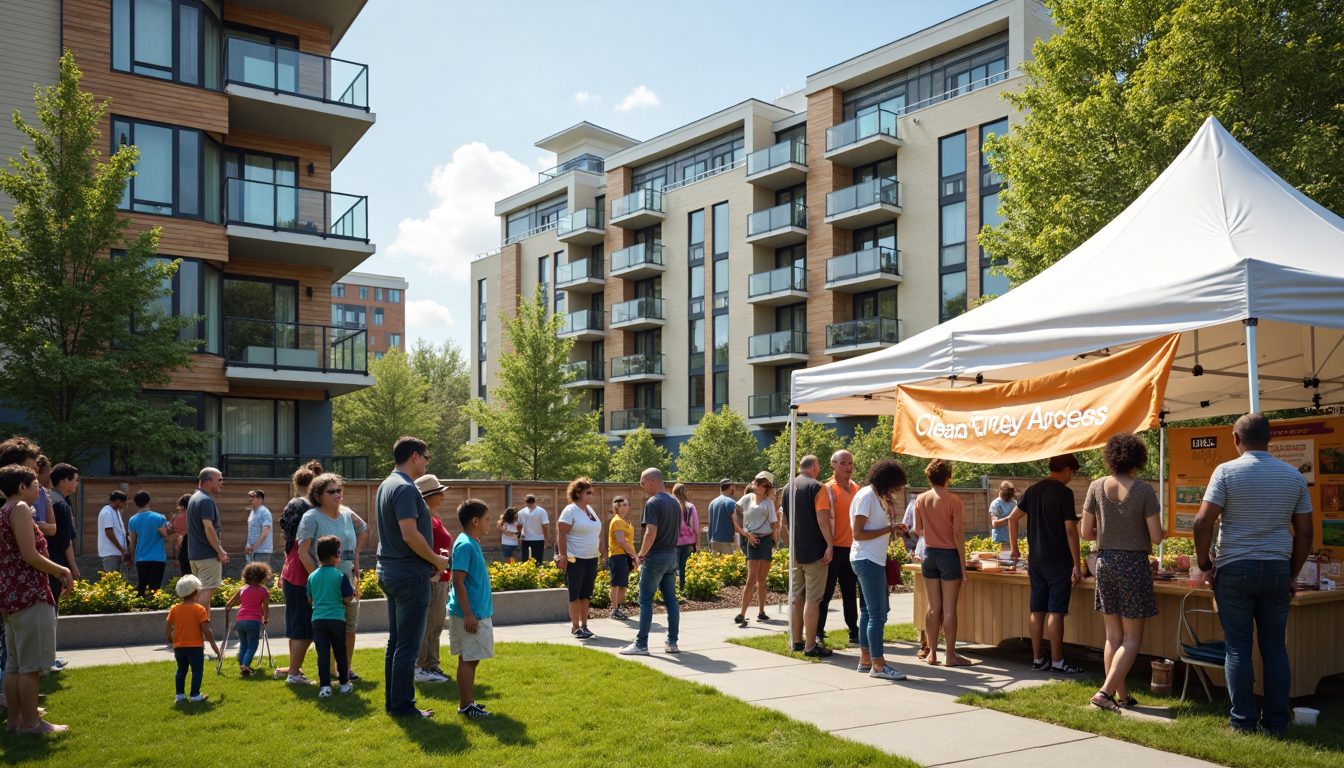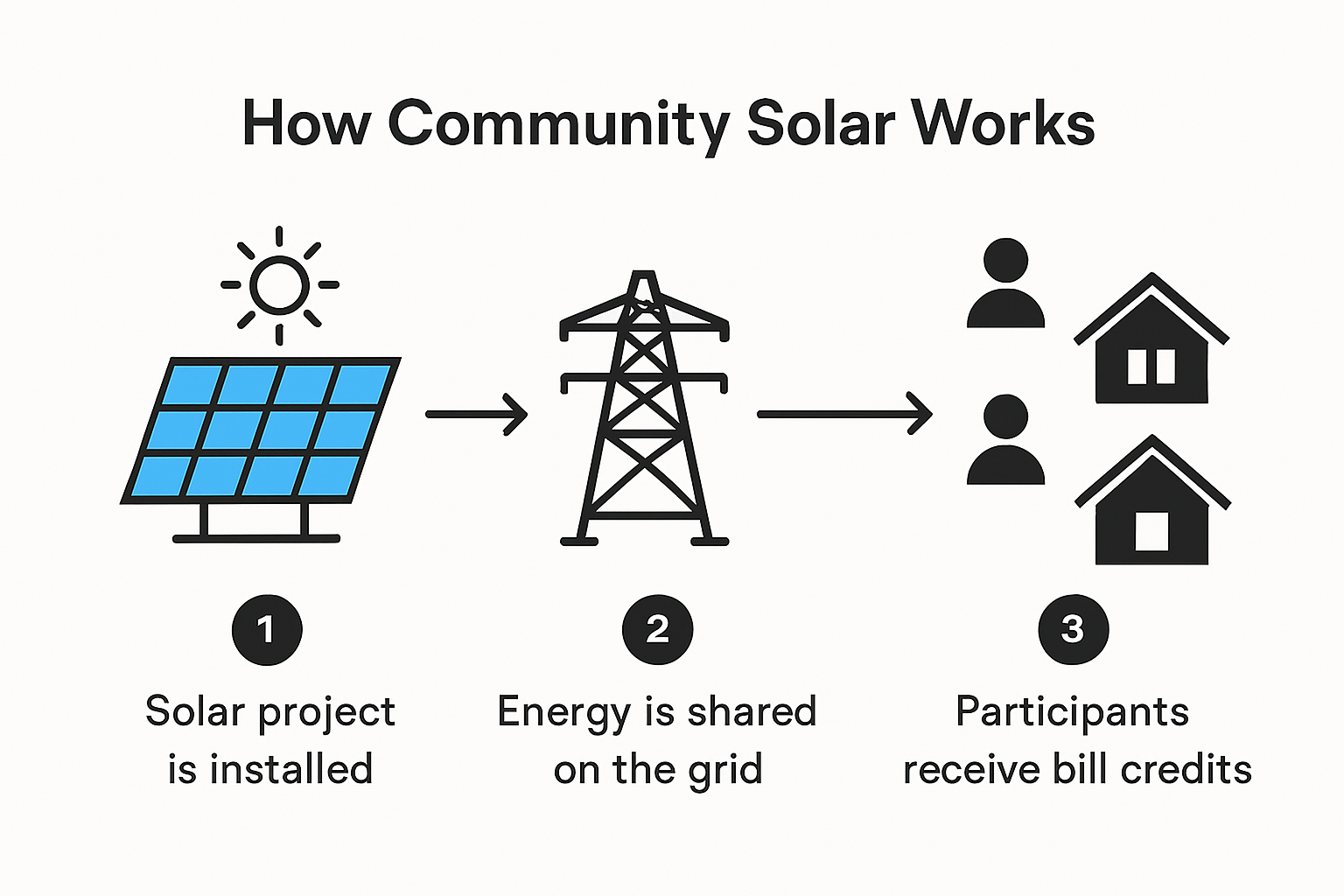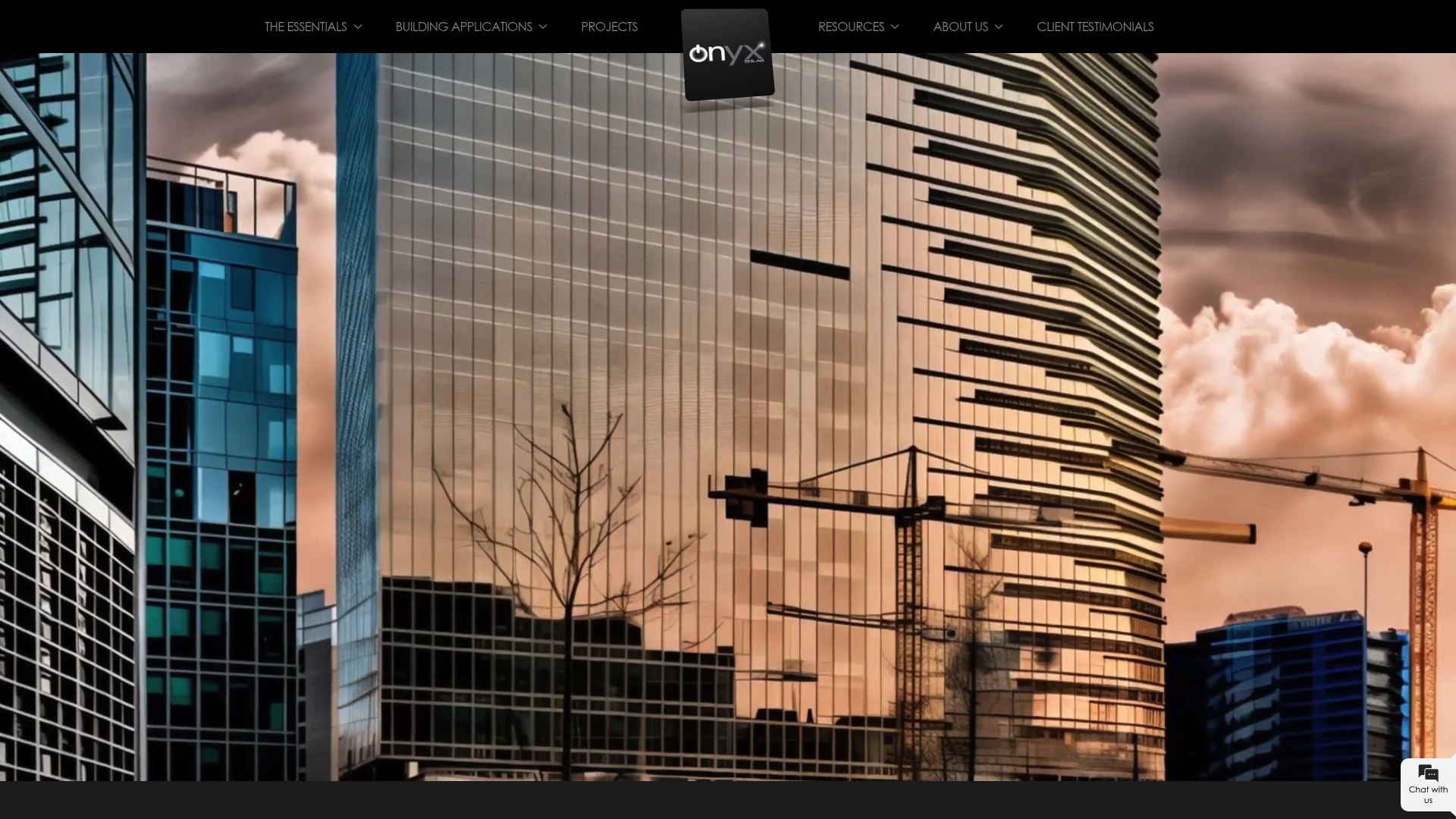
July 16, 2025
Onyx Solar USA
79 Madison Avenue, Ste. #231
New York, NY 10016
usa@onyxsolar.com
+1 917 261 4783
Onyx Solar Spain
Calle Río Cea 1, 46,
05004 Ávila. Spain.
info@onyxsolar.com
+34 920 21 00 50

Community solar is getting a major upgrade in 2025, with developers and cities racing to expand clean energy access. Here’s a head-turner. The Department of Energy is aiming for community solar systems to power 5 million homes and generate $1 billion in energy savings by 2025. Most people assume solar is just for property owners or big companies. The real shift is how these projects are designed to include renters and low-income families, turning solar from an exclusive option into a practical community benefit.
| Takeaway | Explanation |
|---|---|
| Inclusive Access is Key | Successful community solar projects should provide flexible subscription models to accommodate diverse economic backgrounds, including renters and low-income households, ensuring everyone can benefit from solar energy. |
| Strategic Planning and Engagement | Developers need to create detailed Community Solar Action Plans that foster community outreach and ensure ongoing stakeholder engagement, enabling participants to understand and actively benefit from solar initiatives. |
| Navigating Regulatory Complexities | Urban solar developers must develop comprehensive legal strategies to address complex federal and state regulations, including proactive relationships with local government and understanding local zoning laws, to mitigate project risks. |
| Community Engagement is Essential | Effective community engagement should include multilingual communication and interactive educational workshops, demonstrating tangible benefits such as energy savings and job creation to foster support for the projects. |
| Technical and Financial Feasibility | Conducting thorough technical assessments of site viability and developing innovative financial models with clear, transparent billing mechanisms are crucial for the success of community solar projects. |
The solar energy sector is undergoing a transformative shift, with community solar projects emerging as a powerful strategy for democratizing renewable energy access. Learn more about solar energy innovations that are reshaping how communities approach sustainable energy solutions.
Community solar projects represent a collaborative approach to renewable energy generation, allowing multiple participants to share the benefits of a single solar installation. According to the U.S. Department of Energy, these projects enable individuals, businesses, and organizations to access solar energy without installing panels on their own properties.
The national landscape is rapidly evolving. The Department of Energy’s National Community Solar Partnership has set ambitious goals to expand community solar systems to power the equivalent of 5 million households by 2025, potentially creating $1 billion in energy savings. This initiative highlights the growing significance of community-based renewable energy solutions.

Successful community solar projects in 2025 will be characterized by several critical elements. First, they must provide inclusive access, allowing participants from diverse economic backgrounds to benefit from solar energy. This means developing flexible subscription models that can accommodate renters, low-income households, and businesses with varying energy consumption needs.
Technological innovation will play a crucial role. Projects will increasingly integrate advanced photovoltaic technologies that maximize energy production while minimizing land use. The focus will shift from simply generating electricity to creating comprehensive energy ecosystems that provide multiple benefits to participating communities.
Regulatory frameworks are also crucial. Developers must navigate complex local and state regulations that govern community solar project implementation. This requires a deep understanding of policy landscapes, incentive structures, and interconnection requirements that can vary significantly between jurisdictions.
Community solar projects offer a unique value proposition that extends beyond individual energy savings. They create local jobs, stimulate economic development, and provide a pathway to more sustainable energy infrastructure. By distributing solar generation across multiple sites and participants, these projects enhance grid resilience and reduce reliance on centralized fossil fuel-based power generation.
Environmentally, community solar represents a strategic approach to decarbonization. By enabling broader participation in renewable energy, these projects accelerate the transition to a cleaner energy ecosystem. They democratize sustainable technology, making renewable energy accessible to communities that might otherwise be excluded from such investments.
As we approach 2025, community solar projects will continue to evolve. Developers who can combine technological innovation, inclusive design, and strategic regulatory navigation will be best positioned to lead this transformative energy transition.
Community solar projects are transforming the architectural and real estate sectors, offering unprecedented opportunities for sustainable development and economic innovation. Discover innovative solar integration strategies that are redefining how buildings interact with renewable energy systems.
Real estate developers and property owners are discovering significant financial advantages through community solar projects. According to EDPR North America, commercial properties can generate additional revenue streams by strategically leasing rooftops, parking lots, and adjacent land for solar installations.
Property values experience notable appreciation when integrated with community solar systems. Research from Solar Real Estate Valuation Institute indicates that solar-equipped buildings often command higher market prices and attract a broader range of environmentally conscious investors and tenants. This valuation boost stems from the perceived long-term energy cost savings and sustainability credentials associated with such properties.
Architects are increasingly viewing community solar projects as opportunities for innovative design solutions. These projects enable seamless integration of renewable energy systems into building aesthetics, moving beyond traditional solar panel installations. The focus has shifted towards creating energy-generating architectural elements that serve multiple functional and aesthetic purposes.
Modern architectural approaches emphasize blending renewable energy infrastructure with building design. This means developing solar solutions that are not merely add-ons but integral components of the architectural vision. Photovoltaic glass, solar-integrated facades, and adaptive building envelopes represent cutting-edge approaches that transform energy generation from a technical necessity into an architectural statement.
Commercial real estate properties equipped with community solar installations gain a significant competitive edge in attracting and retaining tenants. Sustainable Property Insights reveals that environmentally conscious tenants increasingly prioritize buildings with demonstrable sustainability credentials.
The benefits extend beyond aesthetic appeal. Tenants recognize the potential for reduced energy costs, improved environmental performance, and alignment with corporate sustainability goals. Properties that offer community solar participation provide tenants with an opportunity to contribute to renewable energy generation without requiring individual infrastructure investments.
As the real estate and architectural sectors continue evolving, community solar projects represent more than an environmental strategy. They are becoming a sophisticated approach to design, financial management, and sustainable urban development. Developers and architects who embrace these innovations will be well-positioned to lead the next generation of built environments.

Successful community solar project integration requires a strategic and comprehensive approach that addresses technical, regulatory, and community engagement challenges. Explore advanced solar implementation strategies that can transform complex projects into streamlined renewable energy solutions.
Developing a robust Community Solar Action Plan is crucial for project success. According to University of Massachusetts Agricultural Extension, comprehensive planning should include detailed steps for community outreach, potential solar developer engagement, and alignment of municipal bylaws with community preferences.
Stakeholder engagement goes beyond traditional consultation. Developers must create inclusive platforms that allow community members to understand, participate, and benefit from solar projects. This involves hosting transparent information sessions, developing clear communication channels, and establishing mechanisms for ongoing community feedback and involvement.
Technical feasibility assessment forms the backbone of successful community solar integration. This involves comprehensive site evaluations, solar resource analysis, grid interconnection studies, and detailed financial modeling. Developers must conduct thorough technical due diligence to ensure project viability, optimize energy production, and minimize potential implementation risks.
Financial structuring requires innovative approaches. Projects must develop flexible subscription models that accommodate diverse economic backgrounds. This includes creating low-entry barriers, offering sliding-scale participation options, and ensuring transparent billing mechanisms that provide clear value propositions for participants.
Building trust is paramount in community solar project development. The U.S. Department of Energy emphasizes implementing robust consumer protection measures. This includes ensuring subscribers receive bill credits with at least 20% household savings and providing clear, upfront disclosure documents in the subscriber’s primary language.
Transparency extends to project design, financial structures, and expected outcomes. Developers should provide comprehensive documentation that explains project mechanics, potential savings, environmental impact, and long-term community benefits. Clear, accessible communication helps build credibility and encourages broader participation.
Successful community solar project integration demands a holistic approach that balances technical excellence, financial innovation, and community empowerment. By prioritizing stakeholder engagement, implementing rigorous planning processes, and maintaining unwavering transparency, developers can create renewable energy solutions that truly serve community interests and drive sustainable transformation.
Here is a summary table outlining the key steps for integrating community solar projects as discussed in this section:
| Step | Description |
|---|---|
| Community Solar Action Plan | Develop a comprehensive plan that includes community outreach and aligns with municipal bylaws |
| Stakeholder Engagement | Create inclusive platforms for participation, hold info sessions, and enable ongoing feedback |
| Technical Feasibility Assessment | Conduct site evaluations, resource analysis, interconnection studies, and technical due diligence |
| Financial Structuring | Develop flexible subscription models with low-entry barriers and transparent billing options |
| Consumer Protection Measures | Implement clear disclosures and guarantee minimum household energy savings |
| Transparency in Communications | Provide comprehensive, accessible project and financial information to all community members |
Urban environments present unique complexities for community solar project implementation, requiring sophisticated strategies and innovative problem-solving approaches. Learn about adaptive solar solutions that can transform urban energy challenges into opportunities.
Urban community solar projects face intricate regulatory landscapes that demand nuanced navigation. According to Legal Research on Energy Policies, these projects often encounter complex federal and state regulatory environments characterized by ambiguous permitting requirements and inconsistent policies across jurisdictions.
Successful urban solar developers must develop comprehensive legal strategies that anticipate and mitigate potential regulatory barriers. This involves proactive engagement with local government agencies, detailed policy analysis, and creating flexible project designs that can adapt to evolving regulatory frameworks. Developing strong relationships with municipal authorities and understanding local zoning regulations becomes critical for project advancement.
Urban electrical grid infrastructure presents significant challenges for community solar project implementation. Northeast Energy Network highlights the complexities of integrating renewable energy systems into existing urban electrical networks, which often feature outdated infrastructure and limited capacity.
Addressing these technical challenges requires a multifaceted approach. Developers must conduct comprehensive grid interconnection studies, collaborate with local utility providers, and potentially invest in grid modernization infrastructure. Advanced technologies like smart grid solutions and energy storage systems can help mitigate interconnection limitations and enhance overall project resilience.
Effective community engagement is paramount for successful urban community solar projects. Sustainability Research Consortium emphasizes the importance of early and transparent community involvement in project development.
Developers must create robust community engagement frameworks that go beyond traditional consultation models. This involves developing multilingual communication strategies, hosting interactive workshops, providing clear educational resources about solar technology, and creating mechanisms for ongoing community feedback. Successful projects will demonstrate tangible community benefits, such as energy cost savings, job creation, and environmental improvements.
The table below compares common challenges faced by developers in urban community solar projects and their corresponding solutions as discussed in this section:
| Challenge | Description | Solutions/Strategies |
|---|---|---|
| Regulatory Complexity | Navigating ambiguous, inconsistent regulations | Proactive agency engagement, flexible project design |
| Grid Infrastructure Limitations | Outdated, capacity-limited urban grids | Interconnection studies, grid modernization, storage tech |
| Community Engagement Barriers | Diverse languages, trust, lack of awareness | Multilingual outreach, educational workshops, feedback |
The key to overcoming urban community solar challenges lies in an integrated approach that combines technical innovation, regulatory expertise, and genuine community collaboration. By anticipating potential obstacles and developing flexible, responsive strategies, developers can transform urban energy landscapes and create sustainable, community-driven solar solutions that serve diverse urban populations.
Community solar projects allow multiple participants, including renters and low-income families, to share the benefits of a single solar installation without having to install panels on their own properties.
By 2025, community solar projects are expected to power 5 million homes and create $1 billion in energy savings, helping to democratize access to renewable energy and stimulate local economies.
Successful community solar projects should include inclusive access for diverse participants, technological innovation, navigable regulatory frameworks, and engagement strategies that foster community involvement and understanding.
Developers can overcome urban challenges by engaging with local governments about regulatory complexities, conducting thorough grid infrastructure assessments, and implementing comprehensive community engagement initiatives to build trust and awareness.
Are you facing technical, regulatory, or design barriers as you develop community solar projects for 2025? This article highlights the real challenges confronting developers today, from integrating solar into urban settings to creating inclusive, future-ready energy solutions. Community engagement, flexible solutions for renters, and seamless architectural integration are essential—but it can be tough to find solar technology that checks every box while maintaining high aesthetic standards.

Onyx Solar puts you in control of your project’s success. Our Building Integrated Photovoltaic glass technology is engineered for creative, large-scale developments. With uses ranging from facades to skylights and canopies, Onyx Solar helps you convert everyday building elements into energy generators. Take the next step and explore real-world examples and technical resources so your community solar project not only meets but exceeds modern sustainability demands. Visit Onyx Solar to transform your plans into landmark achievements now while demand for community solar is at a record high.
Over 500 projects completed across 60 countries on all five continents.
Learn how our photovoltaic solutions are shaping the future of architecture.
Explore our full catalogue available in PDF or as an AUDIOBOOK.